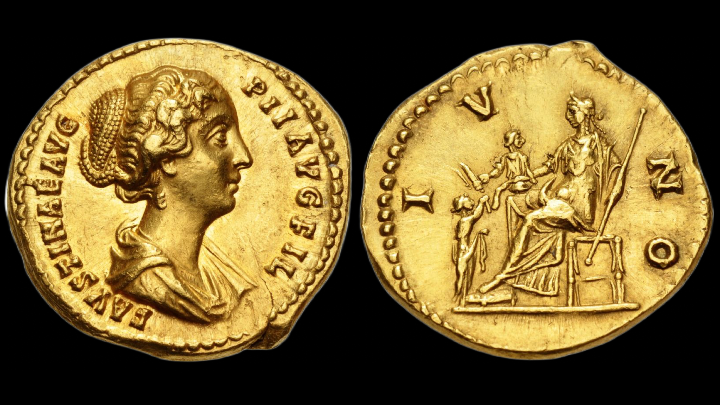In the world of Roman numismatics, some coins stand out not only for their rarity, but also for the power of their symbolism. The aureus of Faustina the Younger, struck around AD 149, is a perfect example.
This aureus serves as a testament to female-centered imperial propaganda, where Faustina is portrayed as a model of domestic virtue — with a clear political message: the stability of the Empire rests on the imperial family.
The Coin: An Aureus Rich in Symbolism
This gold aureus, minted in Rome around AD 149 under the reign of Antoninus Pius, measures 20 mm in diameter and weighs 7.00 g. It is graded EF (Extremely Fine), with minor edge flaws and light marks on the obverse, none of which detract from the overall beauty or legibility of the coin.
🔸 Obverse:
The legend FAVSTINAE AVG PII AVG FIL encircles the draped bust of Faustina the Younger, facing right. Her hair is elegantly styled and tied at the back with pearl bindings. This hairstyle, finely engraved, evokes the refinement of Roman fashion and the dignity of the empress, while also highlighting her status as daughter of Antoninus Pius.
🔸 Reverse:
The goddess Juno (IVNO) is shown diademed, seated left on a low bench. She holds a child on her lap with her right hand, and a transverse scepter in her left. To her left, a second child stands, facing her, holding up two ears of grain.
This scene evokes a sense of divine motherhood, but also serves as an allegory of fertility, protection of children, and domestic stability — all key virtues in Roman imperial ideology. Juno here is a dual figure: both mother of the gods and protector of Roman social order, embodied through Faustina in the public eye.

History: Faustina the Younger, Between Imperial Motherhood and Political Strategy
Daughter of Emperor Antoninus Pius and wife of Marcus Aurelius, Faustina the Younger played a central role in the Antonine dynasty. As Augusta from AD 147, she became the mother of a future imperial lineage — giving birth to several children, including Commodus, who would later become emperor.
This aureus, minted under the authority of her father, emphasizes Faustina’s importance as a dynastic cornerstone, even in the early years of her title as Augusta. Through the image of Juno, the goddess of marriage and motherhood, the coinage reinforces the connection between private virtue and public power.
This coin is especially significant as it was struck shortly after her elevation to Augusta, and likely commemorates an imperial birth or an official recognition of her maternal role within the continuity of power.
A Rare Aureus, Worthy of the Finest Collections
This aureus of Faustina the Younger with Juno is more than just a gold coin — it is a manifesto of its time, celebrating feminine imperial virtues in service of the Roman state. Rich in detail, historically meaningful, and visually refined, it speaks to any collector seeking a blend of beauty, legacy, and rarity.
This very specimen, struck from the same die as the one featured on the cover of Martin Beckmann’s Faustina the Younger: Coinage, Portraits, and Public Image, was sold for $11,000.
📩 If you are looking for this coin, contact us — and we will find it for you.